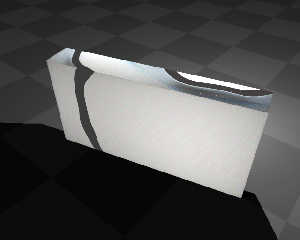|
 |
Today I tested the principle of making a SSLT marble object, lit from behind.
Results are interesting, but not entirely successful. I'll retry it in future
though.
The idea is that the veins permeate through the solid, and have different
absorbent and diffusive properties than the rest of the medium.
The attached image shows a simple box (this can be any CSG-able object), but it
is actually two objects: an isosurface for the veins (dark, and highly
absorbent), and its inverse for the rest of the material (light, and highly
scattering). I've chosen to mimic 'inverse' using phase in the vein pattern,
rather than trying to close off CSG inverses.
Notes to prevent confusion:
1. The floor does not use SSLT.
2. The box is slightly raised from the floor, so the shadow position is OK.
(Speculative!) Observations:
It's not a visually good marble (it won't convince anyone), but I think a
principle is demonstrated here.
1. Dark veins can throw 'shadows' into the material, even when the veins are not
touching (?) the surface of the overall object.
2. The blue back-scattering, and red forward-scattering (a consequence of the
scattering colours) at the top-right of the shape.
3. What I'm not really seeing is the gradual receding of the veins in the bulk
of the material. Someone will probably tell me they can see it (top-left) and
say that I need to tweak parameters of textures, but I think that this marbling
is not possible in the current SSLT implementation, because inner edges can't
see the (discarded filtered pass-through) light. I'd be interested to know the
truth either way.
4. Possible brightness problem at edge of CSG intersections. I don't want to
speculate on the cause, as there are many possible reasons. (Oh, OK then: 1.
Poor CSG coincidences (and is the top face complete?), 2. Perhaps small convex
volumes are problematic).
If/when this SSLT develops, I hope for marbles and woods to be created like this
(a new material library) - obviously with more marble-ish functions (like the
current surface textures), and with a better understanding of the interfaces
between coincident surfaces of different SSLT-enabled materials.
Trace time (not tuned): ~50 mins on Intel Q6600 @ 2.4GHz (640 x 512, +AM2 +a0.4)
Post a reply to this message
Attachments:
Download 'subsurface_test4.jpg' (134 KB)
Preview of image 'subsurface_test4.jpg'

|
 |




![]()